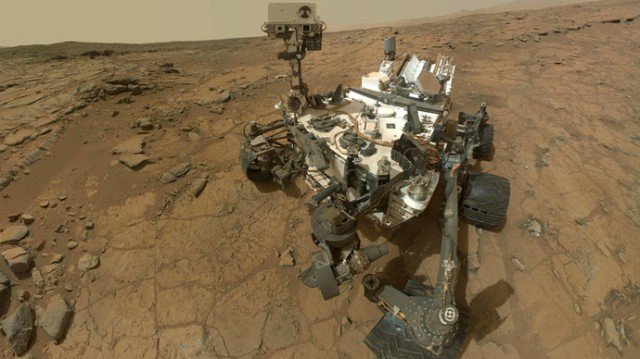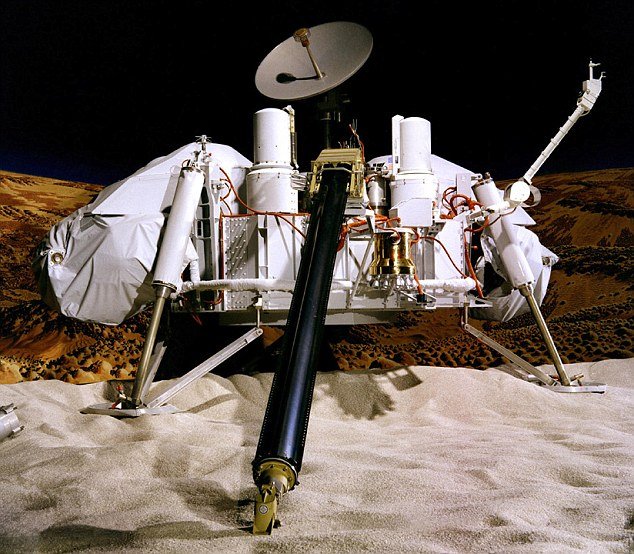According to an analysis done onboard NASA’s Curiosity rover, there is a surprising amount of water bound up in the soil of Mars.
When it heated a small pinch of dirt scooped up from the ground, the most abundant vapor detected was H2O.
Curiosity researcher Laurie Leshin and colleagues tell Science Magazine that Mars’ dusty red covering holds about 2% by weight of water.
This could be a useful resource for future astronauts, they say.

Curiosity soil samples showed that Mars’ dusty red covering holds about 2 percent by weight of water
“If you think about a cubic foot of this dirt and you just heat it a little bit – a few hundred degrees – you’ll actually get off about two pints of water – like two water bottles you’d take to the gym,” Dr. Laurie Leshin explained.
“And this dirt on Mars is interesting because it seems to be about the same everywhere you go. If you are a human explorer, this is really good news because you can quite easily extract water from almost anywhere.”
The revelation about the amount of water chemically bound into the fine-grained particles of the soil is just one nugget of information to come from a series of five papers in the respected journal describing the early exploits of the rover.
Some of this data has been reported previously at science meetings and in NASA press conferences, but the formal write-up gives an opportunity for the wider research community to examine the detail.
[youtube EBjfnIcmSrA]
Scientists have concluded that is 99% certain there is life on Mars after a mathematical analysis of the Red Planet soil samples taken by Viking 1 probe on July 1976.
Viking 1 did find evidence of extraterrestrial microbes in soil samples from the Red Planet.
Mathematical analysis of the samples concluded that salts in the soil on Mars “threw off” initial estimates – and that the soil samples show strong evidence of microbial life.
The new analysis looked for “complexity” in the samples – an indication of life. To the surprise of the scientists, they found it.
“This suggests a robust biological response,” say the researchers, from the University of Siena and California’s Keck Institute.
“These analyses support the interpretation that the Viking LR experiment did detect extant microbial life on Mars.”

Viking 1 probe did find evidence of extraterrestrial microbes in soil samples from Mars
The reassessment was prompted by the discovery of “perchlorates” in the soil at the landing site of another Mars lander, Phoenix, in 2008.
The presence of the chemicals in Viking’s samples had led scientists to conclude the samples were contaminated.
The scientists behind the experiment remain divided over how conclusive the evidence for life on Mars is.
Christopher McKay of NASA’s Ames Research Centre said in an interview with Discovery News: “Finding organics is not evidence of life or evidence of past life. It’s just evidence for organics.”
“The ultimate proof is to take a video of a Martian bacteria. They should send a microscope — watch the bacteria move,” said Josheph Miller of USC’s Keck School of Medicine.
“On the basis of what we’ve done so far, I’d say I’m 99 percent sure there’s life there.”
Future Mars missions may be able to settle the question.
One forthcoming unmanned mission is the new Mars Science Laboratory rover, called Curiosity, scheduled for launch in November.
The $2.5 billion nuclear-powered machine will land on Mars’ surface with a suite of 10 science instruments to try to determine if conditions are favorable for life.
Another key Mars mission is scheduled for 2016. Called the ExoMars Trace Gas Orbiter, it will carry five science instruments and will study gases in Mars’ atmosphere, including methane, for evidence of biological or geological activity.
“The instruments on that atmospheric mission have a factor of 100 to 1,000 increase in sensitivity over what is currently available from Mars orbiters or from ground observations,” said Mark Allen, Ph.D., who is the U.S. project scientist for the 2016 Mars mission.


